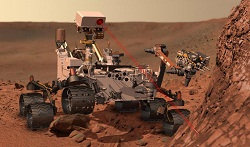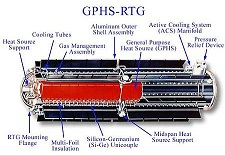Mars Rover Curiosity featured in ReActions
From the American Nuclear Society to teachers interested in the nuclear sciences
 The September/October edition of ReActions, an American Nuclear Society information resource newsletter for teachers, is available online. This issue features NASA's fascinating, nuclear-powered rover Curiosity, which is busy making discoveries as it explores the Gale Crater on the surface of Mars. For example, Curiosity again made news and history just a few weeks ago when it discovered an ancient stream bed, from a time when water flowed across the surface of the red planet.
The September/October edition of ReActions, an American Nuclear Society information resource newsletter for teachers, is available online. This issue features NASA's fascinating, nuclear-powered rover Curiosity, which is busy making discoveries as it explores the Gale Crater on the surface of Mars. For example, Curiosity again made news and history just a few weeks ago when it discovered an ancient stream bed, from a time when water flowed across the surface of the red planet.
 ReActions features some of the many ways that nuclear science and technology is important in everyday life, and includes one of the many classroom group research activities available through ANS. Teachers will want to be sure to use the many ANS information resources available for their students, and the many online information resources in the issue.
ReActions features some of the many ways that nuclear science and technology is important in everyday life, and includes one of the many classroom group research activities available through ANS. Teachers will want to be sure to use the many ANS information resources available for their students, and the many online information resources in the issue.
This issue of ReActions also takes an in-depth look at the hows and whys of the use of radioisotope power systems in historic space missions, such as the Curiosity rover, with guest contributor Wes Deason of the ANS Aerospace Nuclear Science and Technology Professional Division.
 ReActions is a great resource for K-12 science teachers to keep up-to-date on developments in nuclear science education. The newsletter highlights hands-on activities that teachers can use in the classroom, as well as ANS online educational resources and materials.
ReActions is a great resource for K-12 science teachers to keep up-to-date on developments in nuclear science education. The newsletter highlights hands-on activities that teachers can use in the classroom, as well as ANS online educational resources and materials.
ReActions also has information on the upcoming ANS teacher workshops in San Diego (November 10-register now, early registration (save $35) ends this Thursday) and Phoenix (December 6-8 and February 24). See the ReActions issue online for more details.
______________________________










